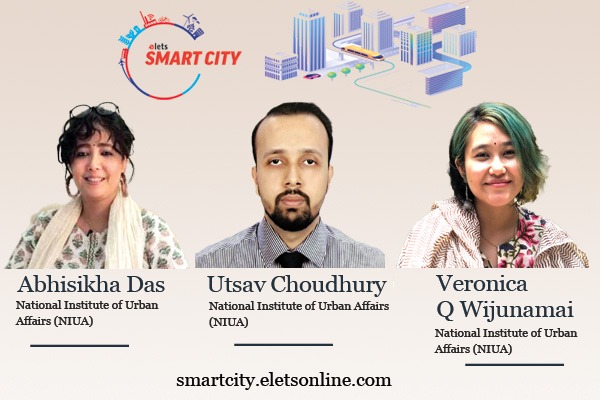
Cities are on a continuum; changing, evolving and adapting to the growing population. They are viewed as the ‘territory and experiential texture for half the global population,’ and are the stage on which diverse communities settle, interact and transform urban space. In contradiction, they are also where practices of exclusion and segregation are so acutely felt in places where communities live¹.
Historically, discrimination on the grounds of sex, ethnic or racial origin and inter alia, have been understood as separate issues, though they have largely interdependency characteristics. Compounded vulnerabilities; where several grounds of intersectionalities and discrimination add to each other at one particular instance: inequalities based on one stratum add to discrimination based on other strata to create an added burden. Democracy by its nature recognizes the equal worth and equal rights of all citizens, through the adherence to the “one person, one vote”- rule. Therefore it is only perceptible to consider equity as the epitome of human rights, belonging to all human beings, without discrimination of any kind. And thus the concept of equity is implicitly embedded in the concept of human rights itself. Equal access to resources and services is the right of every individual.
As resources will always be finite, managing them, accumulating and redistributing these resources is paramount crucial. The concept of marginalisation also arrives in conjunction with the unequal distribution of resources. Inaccessibility to resources presents a higher degree of marginalization and paves the way for vulnerabilities. The problems and challenges of marginalization of certain groups are not the problems of the marginalised groups alone. In order to plan and achieve sustainable economic growth, ULBs need to plan for everyone, which is inclusive in the true sense. Planning and implementing should constitute also the needs and aspirations of marginalized groups like persons with disabilities. As per the Census 2011, the population of persons with disabilities in India is 26.8 million which translates to 2.21% of the country’s total population. There has been an increase in the population with disabilities in India, with the figure rising from 21.9 million in 2001 to 26.8 million over the period of 10 years out of which 8.1 million are enumerated in urban settings. Urban development has recently emerged as a significant priority in the new global sustainable development policy agenda, as evidenced by Sustainable Development Goal No.11 and the Habitat III New Urban Agenda. The urban local bodies (ULBs) need to hold the entitlements and responsibilities of development of the area and uphold the jurisdiction of delivery of services.
The federal structure of India puts onus of formulating policies and programmes with the Centre and states. For the same reason, the state governments are given the responsibilities to formulate and implement policies even for cities under the guidance and advisories of the Central Government (Kundu et.al, 2019). It also influences the organisation of the statistical system where the process of data collection is decentralised and transferred from the Centre to states and then to the districts and their various thematic departments (MOSPI, 2021). As such, ULBs in cities are by design often neglected or sidelined from the urban development process that concerns their growth and development. In many states, elections for (ULBs) are often delayed and are festered with the poor institutional framework, finances, citizen participation and most importantly inadequate devolution of powers (Prasad and Pardhasaradhi, 2020). This dismal condition of ULBs stands in contradiction to the rapid rise in urbanisation in Asian and African countries including India in the past three decades. According to the Government of India, the urban areas in India contributed to 63 per cent of the country’s GDP in 2009-10), and this percentage is projected to increase to 75 per cent of the total GDP by 2030 (McKinsey and Company, 2010).
The importance of cities in the overall development narrative of the country is irrefutable and undeniable. The GoI has over the years attempted to strengthen the cities, notably with the 74th Amendment to improve the functioning of the ULBs in India. The act has been considered a path-breaking initiative to decentralise powers and authorities to the Municipal bodies at different levels. To a large extent, the 74th amendment bill has significantly uplifted the status of ULBs as a significant statutory body within the functioning of the Indian administrative system but there also still exists certain ambiguity in the delegation of roles and responsibilities between states and ULBs. Moreover, the transference of functions has been a slow process since the amendment of the bill along with structural inconsistencies such as non-uniformity in the classification of municipalities, strengths of the municipal councils, roles of municipalities in metropolitan plans and delimitation of wards etc. The inconsistencies as highlighted adversely affect achieving the development objectives charted out for urban areas.
So how can “ULBs” be more efficient and plan better for everyone? Sahasranaman & Bettencourt (2019) identified the lack of, and need for data streamlining to assess the size and development of urban economies to tackle the potential of economic growth in Indian cities. This is to say that, with the amount of potential that the city already holds in improving the country’s economy, the evidence generated from this kind of exercise could help situate cities in bringing more recognition from states and motivating them to devolve more power to cities for economic growth. Moreover, data plays a crucial role in efficiently delivering services to every section of society irrespective of caste, gender, sex, economic background and other relational marginalisation. The dialogue on service delivery also encompasses the rights to these services. However, to fulfil the commitment to Leave No One Behind, a crucial enabler is good and reliable data. Cities, in India and globally, are becoming increasingly reliant on data to take decisions on designing spaces and planning for development, as such it becomes exceedingly important to have data that is representative of persons with disabilities and inclusive of their needs and experiences. For, instance, with the increase of climate change-induced disasters, data becomes even more crucial to take a preemptive approach to strategise plans of action. Therefore, inclusive data or data acquired through a participatory process can be a key factor in eliminating discrimination based on disability and instead accelerate efforts and empowerment towards disability-inclusive programming. The production of inclusive data demands the involvement of persons with disabilities in the entire chain of the data collection process and its outcomes. Such an approach ensures inclusion beyond just representation and adequately reflects the nuances in the evidence being generated.
Also Read | Catalysing Urban Capacities in India: A Case of NULP
There are innumerable questions to be addressed to understand how marginalised groups especially persons with disabilities are mapped with their needs and aspirations for the delivery of welfare and services. How can we use data to improve the quality of life of an individual? What if that individual is a person with disabilities living in a low-income neighbourhood with limited access to basic services? What if that person with disabilities is a woman? The unavailability of disaggregated disability urban data can lead to haphazard and non-uniformity of planning and development. In glancing through the disability data available through the Census of India, National Sample Survey Organization, National Health and Family Survey and others, the data points are not representatives and can capture the quality and capabilities of persons with disabilities towards dissemination of services like water sanitation or even building anganwadis or special schools or shelter homes.
In this respect, the National Institute of Urban Affairs (NIUA) in collaboration with the United Nations Educational, Scientific and Cultural Organization (UNESCO) and support from the Ministry of Housing and Urban Affairs through its programme “Building Accessible, Safe & Inclusive Indian Cities” (BASIIC) has undertaken an initiative called the ‘Good Governance for Urban Inclusion Through Data and Empowerment of Persons with Disabilities’ (GUIDE). The initiative piloted in Varanasi seeks to strengthen participatory data systems, on issues related to disability inclusion at the city level, and provide the evidence needed for city planners to design, revise, and adapt plans and programmes to be disability inclusive. GUIDE advocates the importance of local participation i.e., persons with disabilities from the community, local non-government organisations working on the problems concerning persons with disabilities, civil society groups, and sectoral experts from the local government departments among other things*.
Views expressed by: Abhisikha Das, Utsav Choudhury, Veronica Q Wijunamai, National Institute of Urban Affairs (NIUA)
1. United Nations Department of Economic and Social Affairs Division for Social Policy and Development In collaboration with the Government of Finland, 2008
2. Abhishek, N., Jenamani, M., & Mahanty, B, 2017
3. Pieterse and Parnell 2017; Acuto and Parnell 2016 *For more detailed informatiouto and Parnell 2016n about the initiative. Read the report on ‘Making Data Work for Persons with Disabilities’
https://niua.in/intranet/sites/default/files/2869.pdf





















